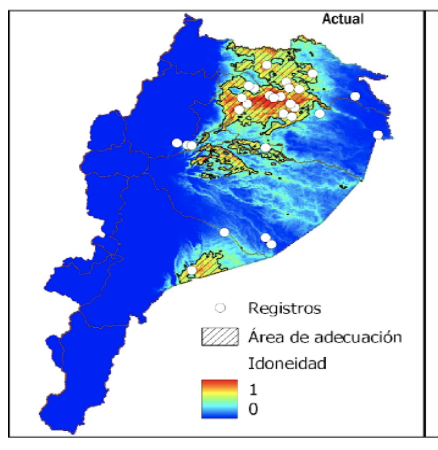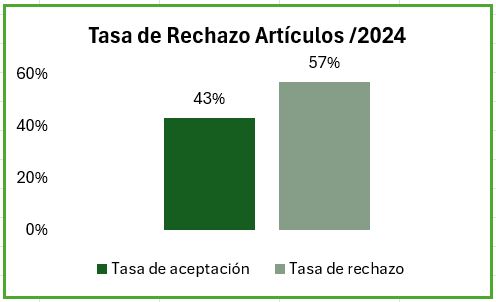Impacts of climate change on the potential distribution of prioritized forest species in the Ecuadorian Amazon
DOI:
https://doi.org/10.54753/blc.v14i1.2115Keywords:
Ecological niche model, species distribution model, climate change, Maxent, amazon tropical forestAbstract
Tropical Rainforests (TF) are ecosystems of great structural and environmental complexity, where they harbor a great diversity of species and habitats, playing an important role in climate regulation and efficient for water conservation. In Ecuador, these forests cover a large part of its territory, specifically in the Chocó and Amazon regions. The objective of this study was to evaluate the impacts of climate change on the distribution of forest species of the BHT, for which five species were selected such as C. spruceanum, C. decorticans, C. pentandra, D. tessmannii and E. uncinatum. uncinatum, and with the help of WorldClim bioclimatic variables, programs such as Maxent, Rstudio and ArcGIS, the Global Circulation Model HadGEM3 - CG3.1 - LL and the SSP2-4.5 and SSP5-8.5 scenarios for the years 2041 and 2060, with which the final model was calibrated and generated. In this way, models of current and future potential distribution of five forest species were projected, in which the effects of climate change were observed, showing increases and reductions in their suitable areas. Some species will adapt and disperse to new sites, and others will limit their survival, causing changes in their distribution patterns. In conclusion, climate change will bring alterations in the dynamics of Amazonian forests, causing changes in their structure and composition. Therefore, this research will be an essential tool to generate policies and strategies for sustainable forest use, restoration and conservation of the biodiversity of these forests.References
Astorga, F., L. E. Escobar, D. Poo-Muñoz, J. Escobar-Dodero, S. Rojas-Hucks, M. Alvarado-Rybak, et al. 2018. Distributional ecology of Andes hantavirus: a macroecological approach. International Journal of Health Geographics 17(1):22. https://doi.org/10.1186/s12942-018-0142-z.
Bakkenes, M., Alkemade, J. R. M., Ihle, F., Leemans, R., y Latour, J. B. (2002). Assessing effects of forecasted climate change on the diversity and distribution of European higher plants for 2050. Global change biology, 8(4), 390-407.
BNDB. (2022). Instituto Nacional de Biodiversidad. https://bndb.sisbioecuador.bio/bndb/index.php
Borja, M., Villacis, S., Torres, R., Acosta, A., y Josse, C. (09 de diciembre 2022). Amazonía ecuatoriana. Coberturas naturales remanentes y deforestación. Recuperado 16 de agosto 2023. MapBiomas Amazonia. https://storymaps.arcgis.com/stories/15ecfd40149649afa28643e2d57195fc
Brown, J. (2014). SDMtoolbox: a python-based GIS toolkit for landscape genetic, biogeographic and species distribution model analyses. Methods in Ecology and Evolution, 5(7), 694–700. https://doi.org/10.1111/2041-210X.12200
Cabrera, J. B. Z., Morales, K. A. L., Guerrero, J. N. Q., Batista, R. M. G., y Jarrín, B. A. R. (2021). Incendios forestales un factor influyente en la degradación de la biodiversidad del cantón Chilla, Ecuador. Revista Científica del Amazonas, 4(7), 5-12.
Calderón-Arguedas, O., y Troyo, A. (2007). Evaluación del nicho ecológico deformas larvales de Aedes aegypti y Culex quinquefasciatus (Díptera: Culicidae) en una comunidad urbana de San José, Costa Rica. Parasitología latinoamericana, 62(3-4), 142-147
Cerón, C., y Montalvo, A. (2002). Etnobotánica Huaorani de Tivacuno-Tiputini Parque NacionalYasuni.https://revistadigital.uce.edu.ec/index.php/CINCHONIA/article/view/2294/2273
Cerón, C., y Reyes, C. (2009). Mondaña, río Napo-Ecuador, Diversidad florística mediante transectos. https://revistadigital.uce.edu.ec/index.php/CINCHONIA/article/view/2351/2330
Chen, I., Hill, J., Ohlemüller, R., Roy, D., y Thomas, C. (2011). Rapid range shifts of species associated with high levels of climate warming. Science, 333(6045), 1024–1026. https://doi.org/10.1126/science.1206432
Cabrera, J. B. Z., Morales, K. A. L., Guerrero, J. N. Q., Batista, R. M. G., y Jarrín, B. A. R. (2021). Incendios forestales un factor influyente en la degradación de la biodiversidad del cantón Chilla, Ecuador. Revista Científica del Amazonas, 4(7), 5-12.
Cobos, M., Townsend P., Barve, N., y Osorio-Olvera, L. (2019). Kuenm: An R package for detailed development of ecological niche models using Maxent. PeerJ, 2019(2), e6281. https://doi.org/10.7717/PEERJ.6281/SUPP-2
Conrad, O., Bechtel, B., Bock, M., Dietrich, H., Fischer, E., Gerlitz, L., Wehberg, J., Wichmann, V., Böhner, J. (2015). System for Automated Geoscientific Analyses (SAGA) v. 2.1.4. Geoscientific Model Development, 8(7), 1991–2007. https://doi.org/10.5194/GMD-8-1991-2015
Cruz, G., Villaseñor, J., López, L., Martínez, E., y Ortiz, E. (2014). Selection of environmental predictors for species distribution modeling in Maxent. https://doi.org/10.5154/r.rchscfa.2013.09.034
Díaz, V., Sosa-Ramírez, J., y Pérez-Salicrup, D. R. (2012). Distribución y abundancia de las especies arbóreas y arbustivas en la Sierra Fría, Aguascalientes, México. Polibotánica, (34), 99-126.
Dirzo, R., Young, H., Mooney, H., y Ceballos, G. (2011). Seasonally dry tropical forests: ecology and conservation. En Seasonally dry tropical forests. Island Press
Escobar, L. E., Lira-Noriega, A., Medina-Vogel, G., y Townsend Peterson, A. (2014). Potential for spread of the white-nose fungus (Pseudogymnoascus destructans) in the Americas: Use of Maxent and NicheA to assure strict model transference. Geospatial Health, 9(1), 221–229. https://doi.org/10.4081/GH.2014.19
Estuardo, C., Vargas, C., y Domian, C. A. (2014). INIAP-Estación Experimental Central Amazónica. INIAP-Estación Experimental Central Amazónica.
Fick, S. E., y Hijmans, R. J. (2017). WorldClim 2: new 1‐km spatial resolution climate surfaces for global land areas. International journal of climatology, 37(12), 4302-4315.
Gentry, A. H. (1982). Neotropical floristic diversity: phytogeographical connections between Central and South America, Pleistocene climatic fluctuations, ¿or an accident of the Andean orogeny? Annals - Missouri Botanical Garden, 69(3), 557–593. https://doi.org/10.2307/2399084
GBIF. (2018). Global Biodiversity Information Facility. https://www.gbif.org/es/
Gil, R., Flores - Armillas, V., Arroyo - Quiroz, I., y Linaje, M. (2013). Análisis de la vulnerabilidad de la biodiversidad frente al cambio climático del Estado de Morelos. Universidad Autónoma de Morelos.
Gómez-Maqueo, X., y Gamboa-Debuen, A. (2022). The Biology of the Genus Ceiba, a Potential Source for Sustainable Production of Natural Fiber. En Plants (Vol. 11, Número 4). MDPI. https://doi.org/10.3390/plants11040521
Hijmans, R., Cameron, S., Parra, J., Jones, P., y Jarvis, A. (2005). Very high resolution interpolated climate surfaces for global land areas. International Journal of Climatology, 25(15), 1965–1978. https://doi.org/10.1002/JOC.1276
Hill, J. L., y Hill, R. A. (2001). Why are tropical rain forests so species rich? Classifying, reviewing and evaluating theories. Progress in Physical Geography, 25(3), 326–354. https://doi.org/10.1177/030913330102500302
Holdridge, L. (1978). Ecología basada en zonas de vida. Instituto Interamericano de Ciencias Agrícolas. https://repositorio.iica.int/bitstream/handle/11324/7936/BVE19040225e.pdf?sequence=1&isAllowed=y
IPCC. (2019). El cambio climático y la tierra. In P. , Shukla, J. , Skea, E. , Calvo, V. , Masson-Delmotte, H. , Pörtner, D. , Roberts, P. , Zhai, R. , Slade, S. , Connors, R. , van Diemen, M. , Ferrat, E. , Haughey, S. , Luz, S. , Neogi, M. , Pathak, J. , Petzold, J. , Portugal, P. , Vyas, E. , Huntley, … J. Malley (Eds.), Informe especial del IPCC sobre el cambio climático, la desertificación, la degradación de las tierras, la gestión sostenible de las tierras, la seguridad alimentaria y los flujos de gases de efecto invernadero en los ecosistemas terrestres.
Jiménez-Torres, A. (2021). La diversidad mejora el almacenamiento de carbono en los bosques tropicales. RECIMUNDO, 5(3), 316–323.
Larrea, M., Larrea, P., Manosalvas, L., Muñoz, J., Santillan, F., y Saenz M. (2005). Buscando caminos para el desarrollo local. ECOCIENCIA.
Larsen, T. H., Brehm, G., Navarrete, H., Franco, P., Gómez, H., Mena, J. L., ... y Canhos, V. (2012). Desplazamientos de los rangos de distribución y extinciones impulsados por el cambio climático en los Andes tropicales: síntesis y orientaciones. Herzog, SK, Martínez, R., Jorgensen, PM y Tiessen, H. Cambio climático y biodiversidad en los Andes, 57-82.
Laurance, W. F., Oliveira, A. A., Laurance, S. G., Condit, R., Nascimento, H. E. M., Sanchez-Thorin, A. C., Lovejoy, T. E., Andrade, A., D’Angelo, S., Ribeiro, J. E., y Dick, C. W. (2004). Pervasive alteration of tree communities in undisturbed Amazonian forests. Nature, 428(6979), 171–175. https://doi.org/10.1038/nature02383
Lee, J., Marotzke, J., Bala, G., Cao, L., Corti, S., Dunne, J., y Zhou, T. (2023). Future Global Climate: Scenario-based Projections and Near-term Information. In Climate Change 2021 – The Physical Science Basis (pp. 553–672). Cambridge University Press. https://doi.org/10.1017/9781009157896.006
Low, B. W., Zeng, Y., Tan, H. H., y Yeo, D. C. J. (2021). Predictor complexity and feature selection affect Maxent model transferability: Evidence from global freshwater invasive species. Diversity and Distributions, 27(3), 497–511. https://doi.org/10.1111/ddi.13211
Machado, F., Cobos, M., y Peterson, T. (2021). A simulation-based method for selecting calibration areas for ecological niche models and species distribution models. Frontiers of Biogeography, 13(4). https://doi.org/10.21425/F5FBG48814
Molion, C. (1975). A climatonomic study of the energy and moisture fluxes of the amazonas basin with considerations of deforestation effects. The University of Wisconsin-Madison
Mota-Vargas, C., Luévano, A., Ortega-Andrade, M., y Prieto-Torres, D. (2019). Una breve introducción a los modelos de nicho ecológico. Universidad Autónoma del estado de Hidalgo. https://www.researchgate.net/publication/339181920
Muriel, P. (2008). La diversidad de ecosistemas en el Ecuador (H., De la Torre, P., Navarrete, M., Muriel, y H. Balslev, Eds.; Herbario QCA). Enciclopedia de las plantas útiles del Ecuador.
Ordóñez Arcos, C. D. (2019). Amazonía bajo amenaza: Ecuador y Brasil en el marco del cambio climático (Master's thesis, Universidad Andina Simón Bolívar, Sede Ecuador).
Palacio, W., y Jaramillo, N. (2001). Riqueza florística y forestal de los bosques tropicales húmedos del Ecuador e implicaciones para su manejo. Recursos Naturales y Ambiente, (36). https://www.researchgate.net/publication/284178323
Palacios, W., Vásquez E., Ministerio del Ambiente, Agua y Transición Ecológica, Ministerios de Agricultura y Ganadería, FAO, PNUD. (2022). Catálogo Dendrológico y Anatómico de especies Forestales. https://actoresproductivos.com/catalogo-forestal-de-51-especies-de-ecuador-disponible-en-linea/
Pardo, R. (2022). Aulatig. Nuevas tecnologías de información geográfica (TIGS) para la docencia en geografía física: drones, podcasts y SIGS como herramientas para la elaboración de material didáctico audiovisual y cartográfico digital. Universidad de Granada. https://doi.org/DOI:10.13140/RG.2.2.11195.08489
Peñuelas, J., Sabaté, S., Filella, I., y Gracia, C. (2004). Efectos del cambio climático sobre los ecosistemas terrestres: observación, experimentación y simulación. In Ecología del bosque mediterráneo en un mundo cambiante (p. 425-460.).
Pliscoff, P., y Fuentes-Castillo, T. (2011). Modelación de la distribución de especies y ecosistemas en el tiempo y en el espacio: una revisión de las nuevas herramientas y enfoques disponibles. Revista de Geografía Norte Grande, 48, 61–79. https://doi.org/10.4067/S0718-34022011000100005
Pulliam, H. (2000). On the relationship between niche and distribution. Ecology Letters. https://onlinelibrary.wiley.com/doi/epdf/10.1046/j.1461-0248.2000.00143.x
Rahm, E., y Do, H. (2000). Data cleaning: Problems and current approaches. IEEE Data Eng. Bull. http://list.research.microsoft.com/scripts/lyris.pl?enter=debull.
Ron, R., Merino, A. (2000). Amphibian declines in Ecuador: overview and first report of chytridiomycosis from South America. Froglog, 42, 2-3.
Root, T. L., MacMynowski, D. P., Mastrandrea, M. D., y Schneider, S. H. (2005). Human-modified temperatures induce species changes: joint attribution. Proceedings of the National Academy of Sciences, 102(21), 7465-7469.
Secretaria Nacional de Gestión de Riesgos. (2022). Incendios-Forestales-01012022-a-03102022rv.https://www.gestionderiesgos.gob.ec/wpcontent/uploads/downloads/2022/08/SITREP-No-01-Incendios_Forestales-01-de-Enero-a-24-08-2022-2.pdf
Sierra, R. (1999). Propuesta preliminar de un sistema de clasificación de vegetación para el Ecuador continental. Propuesta Preliminar de un Sistema de Clasificación de Vegetación para el Ecuador Continental., January 1999, 194. https://doi.org/10.3/JQUERY-UI.JS
Stevenson, P., y Rodríguez, M. (2008). Determinantes de la Composición Florística y Efecto de Borde en un Fragmento de Bosque en el Guaviare, Amazonia colombiana. En Revista Colombia Forestal (Vol. 11).
Torres, B., Maza, O., Aguirre, P., Hinojosa, L., y Günter, S. (2015). The Contribution of Traditional Agroforestry to Climate Change Adaptation in the Ecuadorian Amazon: The Chakra System. En Handbook of Climate Change Adaptation (pp. 1973–1994). Springer Berlin Heidelberg. https://doi.org/10.1007/978-3-642-38670-1_102
Uribe, E. (2015). El cambio climático y sus efectos en la biodiversidad en América Latina. In Comisión Económica para América Latina y el Caribe (CEPAL). https://hdl.handle.net/11362/39855
Ushiñahua, D. (2016). Comportamiento fenológico preliminar de Capirona en la provincia de San Martín, región San Martín. http://repositorio.inia.gob.pe/handle/20.500.12955/213
Varela, S. B. (2019). Modelos de Distribución Potencial y Escenarios de Cambio Climático para cinco Especies de Aves Amenazadas en Ecuador. http://riull.ull.es/xmlui/handle/915/14777
Yánez, P., Núñez, M., Carrera, F., y Martínez, C. (2011). Posibles efectos del cambio climático global en zonas silvestres protegidas de la zona andina de Ecuador. LA GRANJA. Revista de Ciencias de la Vida, 14(2), 24-44.
Young, K. R. (2006). Bosques húmedos. Botánica Económica de los Andes Centrales., 121-129.https://www.researchgate.net/profile/KennethYoung4/publication/228357517_Boses_humedos/links/0c960522e1eafafdf6000000/Bosques-humedos.pdf

Published
How to Cite
Issue
Section
License
Copyright (c) 2024 Bosques Latitud Cero

This work is licensed under a Creative Commons Attribution-NonCommercial-ShareAlike 4.0 International License.
This work is published under the Creative Commons Attribution-NonCommercial-ShareAlike 4.0 International (CC BY-NC-SA 4.0) license. This means that users may copy, distribute, and adapt the content, provided that proper credit is given to the authors and the journal. Commercial use of the material is not permitted. Additionally, any derivative work must be distributed under the same license. This license ensures open access to knowledge, promoting the dissemination and reuse of published works for non-commercial purposes, respecting authorship, and ensuring the free circulation of content under fair terms.




























